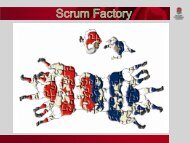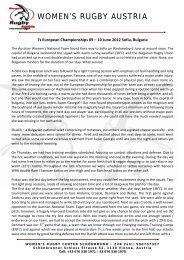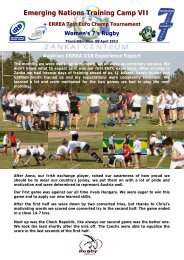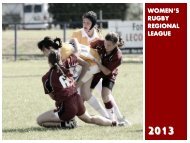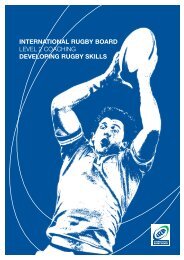Anatomical Adaptation - womensrugby.at
Anatomical Adaptation - womensrugby.at
Anatomical Adaptation - womensrugby.at
- No tags were found...
You also want an ePaper? Increase the reach of your titles
YUMPU automatically turns print PDFs into web optimized ePapers that Google loves.
STRENGTH &CONDITIONING<strong>An<strong>at</strong>omical</strong> <strong>Adapt<strong>at</strong>ion</strong>Acute training variablesThe Strength and Conditioning coach can apply the acute training variables to manage the workload during eachtraining unit or session. The acute training variables include:• Frequency - the number of training units in a week• Intensity - the effort of the exercise• Time - the dur<strong>at</strong>ion of exercise (or repetitions) prescribed• Type - the choice and order of exerciseDepending on the stage of development of the players and the opportunity for training, the Strength and Conditioningcoach may complete such a programme 1-3 times a week.The repetitions used within any exercise in a circuit may vary but typically may be medium to high (from 6-15repetitions) and can combine body weight, medicine balls, pulleys, tubing, Swiss balls, dumbbells, broom handles orany other props or equipment th<strong>at</strong> will gradually provide an overload or gre<strong>at</strong>er resistance challenge to the player. Thegoal is to set a found<strong>at</strong>ion of general strength, stability, mobility and good movement skills during the <strong>An<strong>at</strong>omical</strong><strong>Adapt<strong>at</strong>ion</strong> phase. Our sample routine minimises the use of exercise equipment. However, the Strength andConditioning coach is encouraged to use a much wider range of exercises including external loaded exercises (but notusing near maximum or maximum external loads). The choice will ultim<strong>at</strong>ely depend on the equipment available as wellas the fitness st<strong>at</strong>us of the player.Benefits of the <strong>An<strong>at</strong>omical</strong> <strong>Adapt<strong>at</strong>ion</strong> phaseIt has been shown th<strong>at</strong> when players add an individualised conditioning programme th<strong>at</strong> takes account of the individualplayer’s physical needs in addition to their team skill and practice training th<strong>at</strong> gre<strong>at</strong>er gains in terms of fitness occur(Andrzejewski et al, 2011, Rhea et al, 2009, Gilligan et al, 2005). As st<strong>at</strong>ed earlier, <strong>An<strong>at</strong>omical</strong> <strong>Adapt<strong>at</strong>ion</strong> exercises anddrills can be manipul<strong>at</strong>ed to suit the needs of the players.The benefits of completing a varied, needs-rel<strong>at</strong>ed training programme such as an <strong>An<strong>at</strong>omical</strong> <strong>Adapt<strong>at</strong>ion</strong> phase oftraining include:• A reduced risk of injury• Gre<strong>at</strong>er stability development• Improved range of motion or flexibility development• Better movement mechanics• Enhanced strength, power and speed• Better found<strong>at</strong>ion for l<strong>at</strong>er strength training(Andrzejewski et al, 2011, Rhea et al, 2009, Gilligan et al, 2005, Bompa, 2000)IRB LEVEL 1 STRENGTH & CONDITIONING2



